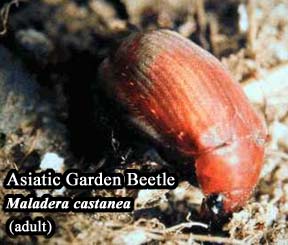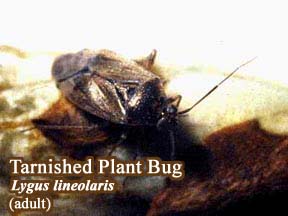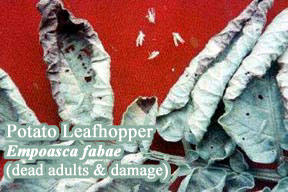Dahlia (Dahlia)
Plant Health Problems
Diseases caused by Fungi:
Powdery mildew, Erysiphe.
White powdery spots or patches develop on leaves and occasionally on stems. Symptoms often first appear on the upper surfaces of the leaves and are usually most pronounced during hot, humid weather. Heavily infected leaves turn brown and shrivel.
Disease can be minimized by avoiding overcrowded spacing of plants and by carefully picking off affected leaves as soon as symptoms are evident. Symptomatic leaves can be placed into a plastic bag in order to avoid spreading the spores of the fungus to other plants. Use of fungicides is usually not necessary. However, applications can be made as soon as symptoms are visible. Among the compounds registered for use in Connecticut are horticultural oil, sulfur, potassium bicarbonate, and thiophanate-methyl. Consult the label for dosage rates and safety precautions.
Wilt, Fusarium sp., Verticillium sp.
Plants may be attacked at any stage. Young plants can suddenly dry up or older plants might develop a pale green color accompanied by wilting of lower leaves, often first appearing on one side of the plant. This is frequently followed by a general wilting and death of the entire plant. Plants may wilt in the middle of the day and seem to recover at night. Some plants may show no signs of infection until they come into flower, when they suddenly collapse. When the stem is cut, a brown discoloration or streaking may appear in the vascular tissues.
Control of these diseases is difficult since the pathogens are commonly found in soil. One of the key strategies for control of vascular wilts is prevention. Therefore, it is important to avoid planting dahlia in infested soil. It is also helpful to maximize plant vigor by good cultural care and watering. Careful handling of plants will avoid root injury which enables the fungus to enter the plant. Since repeated use of the same area greatly increases the amount of disease, rotation is essential. When available, it is also helpful to use resistant varieties. Chemical controls are not effective for these fungi.
Botrytis blight, Botrytis cinerea.
Flowers turn a papery brown and become covered with gray, fuzzy masses. Senescing flowers are particularly susceptible. Tan to brown spots with a target-like appearance can also develop on the leaves. These patches are often associated with flowers which have dropped onto the leaf surface. This disease is particularly troublesome during periods of extended cloudy, humid, wet weather.
Good sanitation practices including grooming the plants and removing spent or senescing flowers can minimize the potential for infection. These affected tissues should be carefully removed and discarded when they are dry. It is also important to avoid wetting the flowers when watering and crowding plants. Adequate spacing between the plants can promote good air circulation. Control can also be achieved with the use of fungicide sprays applied as soon as symptoms are visible. Among the compounds registered for use in Connecticut are mancozeb and thiophanate-methyl. Consult the label for dosage rates and safety precautions.
Diseases caused by Viruses:
Impatiens necrotic spot and Tomato spotted wilt, viruses (INSV and TSWV).
Symptoms can appear as a yellow line pattern on the leaves or as yellow ringspots or blotches. These pathogens are transmitted by the western flower thrips.
Control of this disease is focused on prevention since once plants are infected, they cannot be cured. It is important to eliminate and remove infected plants as soon as they are recognized and to eliminate other symptomatic plants since these viruses have a very broad host range. It is also critical to manage the thrips population.
Diseases caused by Nematodes:
Foliar nematodes, Aphelenchoides spp.
These plant-parasitic worms attack virtually all plant parts and may cause leaf lesions, yellowing, necrosis and leaf drop, and bud malformation. Lower leaves first show brown wedge-shaped areas between the veins which eventually involve the entire leaf. Discoloration then progresses from the bottom to the top of the plant. The nematodes live and move in water films.
Reducing leaf moisture and removal of infected tissues, debris, or plants is important.
Insect Problems: Asiatic garden beetle, Maladera castanea.
Asiatic garden beetle, Maladera castanea.
The grubs of this imported insect also feed on the roots of grass and are responsible for considerable injury to lawns. The life history is similar to that of the oriental beetle, but adults fly more and are attracted to lights. Adults feed at night on many kinds of plants, especially aster, barberry, bean, cherry, chrysanthemum, currant, dahlia, geranium, catalpa, seedling conifers, rhododendrons and strawberries. During the day, the beetles, which hide in the soil around the plants, are seldom seen unless one knows where to find them. The beetle is about 3/4" long, velvety cinnamon brown with a faint iridescence.
Treating the lawns with insecticides described under oriental beetle usually gives effective control. Asiatic garden beetle appears to be the least susceptible of the four common exotic scarabs to imidacloprid, and also may not be controlled with halofenozide. Trichlorfon appears to work well, however.
Cyclamen mite, Phytonemus pallidus.
This translucent, microscopic mite often infests the new leaf and blossom buds, and can proliferate on spent blossoms. Characteristic injury includes dwarfed, thickened and wrinkled leaves. On azalea, dahlia, and other plants with stems, the distance between internodes becomes drastically shortened. Infested plants do not bloom, or blossoms may be misshapen. Cyclamen mite is not easily controlled when mature plants are badly infested: effective miticides are not available to homeowners, so a commercial applicator may be required for effective miticide applications. Effective restricted use products include abamectin, dicofol, and endosulfan. Hot water treatment at 120°F for 15 minutes controls cyclamen mite overwintering on tubers.
European corn borer, Ostrinia nubilalis.
The second generation of this pest lays its eggs on dahlias and sometimes injures them seriously. This insect feeds not only on corn, but also on other crop plants (including potatoes, peppers, and beans), many weeds, and on a variety of other herbaceous plants. The larvae tunnel in the stem in all directions, weakening them so that they break. The larva is pale white or gray with black tubercles and is not more than an inch long when fully grown. Adults have a wingspread of an inch or so and are buff to brown. There are usually two generations annually. Eggs are laid on the underside of leaves, and the larvae tunnel in the stalks and pupate in the burrows. Second generation larvae and those of the single generation corn borer overwinter in the stems and pupate in the spring.
The parasitic wasp Trichogramma has been used for control. This tiny wasp attacks the egg masses of the corn borer, and the eggs of other caterpillars, too. Be sure to purchase the insects from a reputable supplier and make sure the strain you purchase is known to be well adapted to attacking corn borer. Insecticides will harm the Trichogramma wasps.
Giant hornet, Vespa crabro.
This is the largest hornet occurring in Connecticut, with the body being more than an inch long. The general color is dark brown with a broad band of orange yellow on the rear margin of each abdominal segment. This hornet nests in hollow trees, buildings or underground and gathers wood fibers to be used in constructing the nest. Sometimes it removes the bark from stems of dahlia, lilac, arborvitae, and other shrubs and trees, thus girdling them. If damage is excessive, and the nest can be located, hornet and wasp sprays can be used to destroy it.
 Plant bugs.
Plant bugs.
The fourlined plant bug, Poecilocapsus lineatus and tarnished plant bug, Lygus lineolaris, lay eggs in soft stems. They hatch about the middle of May and the young bugs suck the sap from the tender leaves. They molt five times and when mature, about the middle of June, they have wings and are nearly 1/3" long. The fourlined plant bug is yellow-green, marked lengthwise on the wings with four black stripes alternating with three green stripes. The injury to the leaves consists of sunken areas around the punctures. These areas later appear as circular transparent spots and finally as circular holes. The tarnished plant bug is mottled brownish, 1/5" long, with a yellow "Y" shape pattern on its back. These insects injure the new leaves of many different kinds of annual and perennial plants and shrubs. There is one generation each year of the fourlined plant bug and two to five generations yearly of the tarnished plant bug. The nymphs can be managed by spraying with ultra-fine horticultural oil, insecticidal soap or malathion, which are among the compounds registered for control of this pest in Connecticut. Consult the labels for dosage rates, and safety precautions.
 Potato leafhopper, Empoasca fabae.
Potato leafhopper, Empoasca fabae.
This 1/8" long slender, pale green insect sucks plant juices and causes a blanching of the dahlia foliage. This and other leafhoppers feed on many species of flowers and vegetables. Acephate or carbaryl, which are among the compounds registered for use against this pest in Connecticut, sprayed in mid-June and, if needed, again in July and August should give good control. August treatments may also control the European corn borer. Imidacloprid, applied as a soil drench early in the season, will provide systemic control. Consult the labels for dosage rates and safety precautions.
Stalk borer, Papaipema nebris.
This borer infests an occasional stalk of many kinds of herbaceous plants and it frequently causes rather severe injury to dahlia. As a rule its presence escapes notice until the plant begins to wilt. Then it is too late for the plant to recover. The larva tunnels up and down inside the stem and the top portion usually wilts and later dies. There is one annual generation. The moths emerge in September and October and lay eggs on the stalks of their food plants, in which stage the insect passes the winter. The eggs hatch in May or early June. The young larva begins to feed on the leaves of the nearest food plant, and later tunnels in the stem. The mature larva is nearly 1 1/2" long, grayish brown with one white dorsal stripe and two white lateral stripes on each side. On the front half of the body the lateral stripes are interrupted, and the lower brown stripe extends forward onto the side of the head.
Burning all the old stalks, if allowed and destroying weeds at the edges of the garden helps control this insect. When needed, methoxychlor, which is among the compounds registered for use against this pest in Connecticut, applied as a dust, in June, should control this pest. Consult the label for dosage rates and safety precautions.

